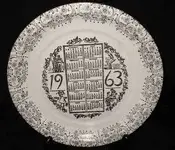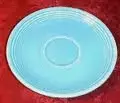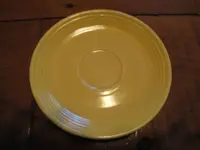Don't know too much about fiestaware but here is some info on the marks-
http://fiestadishes.info/featured/fiesta-markings-dating-your-vintage-fiestaware
Fiesta Backstamps-
Fiesta backstamps are the ink markings that appear on the bottom of the plate. These Fiesta markings all feature the word "Fiesta" in some form as well as some marking identifying Homer Laughlin as the manufacturer.
With Fiesta backstamps that are in INK ONLY, you can identify and old piece of Fiestaware by the case of the letters. Remember these rules:
•If all letters on the "Fiesta" logo are lower case, then the piece of Fiesta is old.
•If the letters on the "Fiesta" logo are upper case, then the piece of Fiesta is new.
Today, there are four (possibly more) different Fiesta markings. These all have capital letters and often have the words "genuine" and "lead free."
Update: For some nice pictures that illustrate a piece of Fiestaware with a vintage looking color but updated ink backstamps, check out these shots taken over at the Selling Vintage blog.
http://sellingvintage.blogspot.com/2010/02/fiestaware-identifying-marks.html
Fiesta Markings for Imprinted Fiesta Logos-
Imprinted Fiesta markings are both difficult to read and have many, many variations. It is very difficult to tell whether a Fiestaware piece is old from its imprinted marking - but it is easy to tell if it is new by the appearance of an "H." Newer Fiesta pieces now have an H stamped below the logo. This was a recent addition, so not all new Fiestaware will have it. However, these rules hold true:
•An "H" appearing on an imprinted Fiestaware marking means it is DEFINITELY new.
•No "H" appearing on an imprinted Fiestaware marking means it MAY BE old but could quite possibly be new.
Circular Fiestaware Markings
Another good indicator of a new piece of Fiestaware is a the new, circular logo. These logos will have a FIESTA HLC USA in a circular pattern, where the word "Fiesta" is actually part of the circle. Again, this is indicative of a new Fiestaware piece but it's absence is not proof that it is an old piece of Fiesta.
Original Fiesta Markings
The original Fiesta markings from between 1936 and 1972 are identifiable in that they include only:
•The word "Fiesta" written in a handwritten styling in all lowercase letters
•The letters HLCO (standing for Homer Laughlin China Co. Sometimes appearing as H-L-Co)
•The letters USA or the words Made in USA.
•The word "Genuine"
Each of these characteristics has its own, somewhat hard to nail down history.
The F in Fiestaware
The F in Fiestaware has changed considerably since the 1930s. The original Fiesta "F" is always lower case and has no loops. The rest of the words in Fiesta are interconnected.
In 1986, when Fiesta was revived, the F in Fiesta was given a distinctive loop, making it appear uppercase. Also, Fiesta started using the Trademark (TM) and Registration (R) symbols after 1986. The remaining letters became disconnected from the F and were then made into all capital letters.
"Genuine" Fiestaware
The word "Genuine" began appearing sometime in the 1940s. This was in response to the many imitation Fiestaware pieces that were produced in the wake of Fiesta's success.
Lead Free Fiestaware
The words "Lead Free" appeared after January 1992. Read our other post for more information about lead and cadmium in Fiestaware.
Date Codes
Also in1992, Fiestaware began bearing date codes. The year is noted by two letters and the month is noted by a single letter. For example, VV is the year code for 2007 and B is the month code for February. A piece made in February 2007 would be stamped with VVB. Homer Laughlin has used date codes on commerical products since 1960, but these codes did not appear on Fiesta until 1992. Here's a handy chart for date codes:
Homer Laughlin Date Codes for Year: Homer Laughlin Date Codes for Month:
•GG - 1992
•HH - 1993
•II - 1994
•JJ - 1995
•KK - 1996
•LL - 1997
•MM - 1998
•NN - 1999
•OO - 2000
•PP - 2001
•QQ - 2002
•RR - 2003
•SS - 2004
•TT - 2005
•UU - 2006
•VV - 2007
•WW - 2008
•XX - 2009
•A - January
•B - February
•C - March
•D - April
•E - May
•F - June
•G - July
•H - August
•I - September
•J - October
•K - November
•L - December
While this is by no means an exhaustive list of Fiestaware markings, this may help you provide clues as to whether your Fiesta is vintage or new. In most cases, it is far easier to determine that Fiestaware is new rather than attemping to prove that it is old. This can be quite frustrating, as many newer Fiesta pieces do resemble original Fiestaware markings. But by knowing which elements appeared later, you can be sure to avoid anyone trying to pass off new Fiesta as old!
 . The platter has HLC fiesta USA stamped in the bottom while the smaller plates have original fiesta (written in script ) HLC USA stamped on the bottom. I also found 2 1963 callander plates 25 cents each. Any help would be great Thanks
. The platter has HLC fiesta USA stamped in the bottom while the smaller plates have original fiesta (written in script ) HLC USA stamped on the bottom. I also found 2 1963 callander plates 25 cents each. Any help would be great Thanks  I had to use stock pics sorry about that camera problems :P
I had to use stock pics sorry about that camera problems :P . The platter has HLC fiesta USA stamped in the bottom while the smaller plates have original fiesta (written in script ) HLC USA stamped on the bottom. I also found 2 1963 callander plates 25 cents each. Any help would be great Thanks
. The platter has HLC fiesta USA stamped in the bottom while the smaller plates have original fiesta (written in script ) HLC USA stamped on the bottom. I also found 2 1963 callander plates 25 cents each. Any help would be great Thanks  I had to use stock pics sorry about that camera problems :P
I had to use stock pics sorry about that camera problems :P






